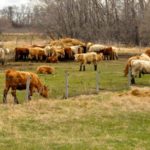
Tag Archives veterinarian

Don’t semen test bulls too young
Animal Health: What are these droplets in young bulls really telling you about semen quality?
Gruesome, but sometimes necessary
Animal Health: When there’s no other options, a dead calf needs to dismembered for removal

Preparedness checklist for calving season
Animal Health: Start with clean facilities and equipment and have all supplies in stock

Watch for newer respiratory pathogens
Animal Health: One is a virus, the other a bacteria — both can be hard to identify

Various treatments for calf diphtheria
Animal Health: Injury to mouth or throat can allow bacteria to set in

Peritonitis more than hardware disease
Animal Health: Understanding the cause can often prevent it from happening again

Determine the risk level of feeder calves
Animal Health: Knowledge of how weaning was handled is useful information

Magnesium key to prevent grass tetany
Animal Health: Chances are that if one animal goes down, others are soon to follow

Tackling coccidiosis on several fronts
There are effective treatments, but the best approach is prevention

Important tips for calf processing
Be properly prepared and do it right – good for cattle and business


